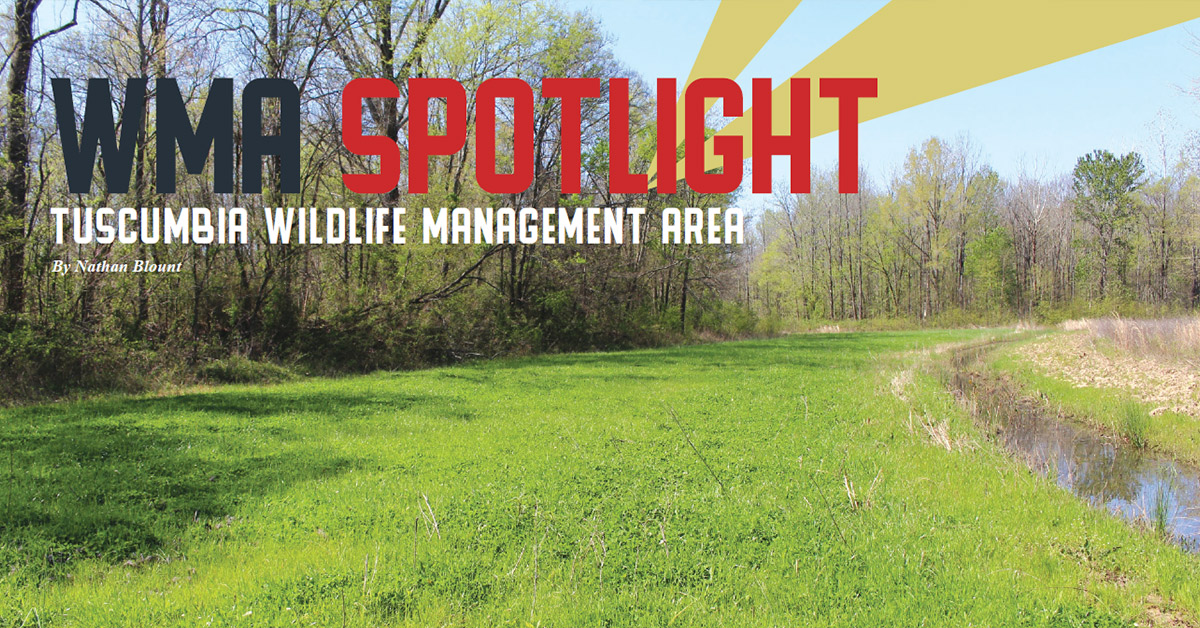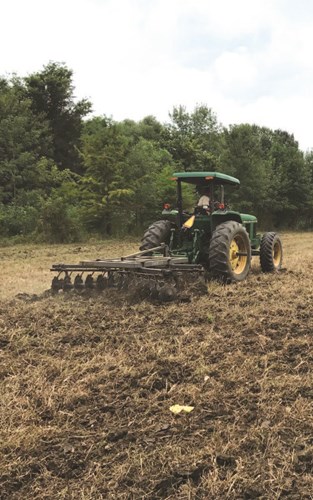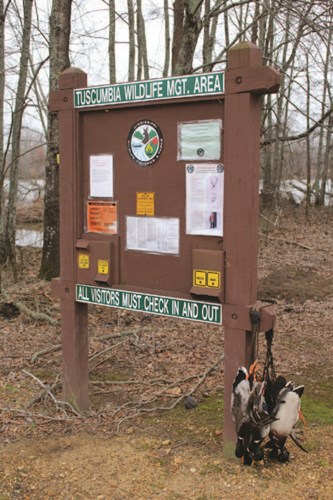WMA Spotlight: Tuscumbia Wildlife Management Area
2/4/2020 3:06:10 PM
By Nathan Blount

Location
In Alcorn County, two miles west of Corinth. Highway 72 runs through the southern portion of the WMA.
History
Established in 1999, the land was acquired by Mississippi Department of Wildlife, Fisheries, and Parks (MDWFP) from the Farmers Home Administration (a former agency of the U.S. Department of Agriculture or USDA). The acquisition was through the Consolidated Farm and Rural Development Act. Terms required the land to be perpetually managed for conservation purposes, including the preservation and maintenance of wetlands and the protection and enhancement of plant and wildlife habitats. The area was officially designated a Wildlife Management Area in 1999.
Lay of the land
Tuscumbia WMA lies within the Tuscumbia River floodplain in the Upper Coastal Plain soil region. Flooding is common during the winter and spring months. The WMA is divided into two separate management units. Unit 1 (1,400 acres), the
northernmost tract, has limited access. A parking area is located on County Road 711, and the unit is also accessible from the Tuscumbia River via boat. Users can launch at the public boat ramp located on County Road 750 (Smith Bridge Road). Unit 2 (1,300 acres) comprises the southern portion of the WMA. Access points are abundant with many parking areas and trails along Highway 72 and County Road 750.
Wildlife habitat
Tuscumbia WMA has a diverse mixture of habitat, which includes swampy-floodplain forests, intensively managed wet-lands, young oak plantation, and small tracts of mixed upland forest. Unit 1 is primarily a permanent wetland. Habitat types include shrub-scrub, emergent, and forested wetlands. Cypress, tupelo gum, and willow are the dominant tree species. Unit 2 is mostly bottomland with a small upland component. The upland portion contains mature mixed hardwood-pine timber as well as young artificially regenerated oak forest. The bottomland is comprised of field-like habitats and varying composition of wooded areas. The wooded portion is comprised primarily of pulp-sized, floodplain species, such as green ash, black willow, black gum, and sycamore. Mature bottomland hardwoods are present along the banks of the Tuscumbia River.
 Unit 2 is intensively managed for waterfowl. In 2000, MDWFP, in cooperation with the USDA Natural Resources Conservation Service and Ducks Unlimited, converted abandoned agricultural fields in Unit 2 into waterfowl impoundments. Federal, state, and private funds were used through a wetland restoration program to fund the project. The results were seven impoundments totaling 257 acres and ranging from 19 to 83 acres in size. The impoundments provide habitat for migrating waterfowl and recreational opportunities for waterfowl hunters.
Unit 2 is intensively managed for waterfowl. In 2000, MDWFP, in cooperation with the USDA Natural Resources Conservation Service and Ducks Unlimited, converted abandoned agricultural fields in Unit 2 into waterfowl impoundments. Federal, state, and private funds were used through a wetland restoration program to fund the project. The results were seven impoundments totaling 257 acres and ranging from 19 to 83 acres in size. The impoundments provide habitat for migrating waterfowl and recreational opportunities for waterfowl hunters.
Moist-soil management is an important tool used on the area to provide food and cover requirements for waterfowl. Impoundments are managed by manually manipulating water levels throughout the year with a system of water control structures. The drawdown of water promotes the germination of desirable native plants on exposed mudflats during the spring and summer months. Approximately 80 acres of supplemental forages such as browntop millet, Japanese millet, and milo are also planted to provide additional high-quality waterfowl food. Rotational disking, herbicide application, and other management techniques are used. Impoundments are re-flooded during the fall and winter to prepare for the upcoming waterfowl migration.
Historically, flooding of impoundments to full capacity was dependent upon periods of heavy rainfall and the Tuscumbia River breaching its banks. As a consequence, during dry years, impoundment levels could remain low well into the winter. Low water levels reduce the amount of available waterfowl habitat and also hunting opportunity. To address this issue, state waterfowl stamp funds were used to install a new water control structure during the summer of 2019. The screw gate structure was placed in the bank of the Tuscumbia River and will allow WMA staff to begin flooding Unit 2 impoundments at lower river levels than previously required. This project could effectively increase waterfowl utilization of the WMA and minimize the loss of hunting opportunity. State duck stamp dollars help fund similar projects throughout the WMA system.
Hunting opportunities
Waterfowl is the main allure for most Tuscumbia WMA hunters. Unit 1 provides plenty of hunting opportunity as the seasons are aligned with the statewide waterfowl seasons. Shooting hours end at 3 p.m. Unit 2 waterfowl hunting is by draw hunt only, except for youth waterfowl days. Draw hunts begin during the second draw period (mid-December) and take place on Saturdays and Wednesdays through the end of the season. Drawn hunters are randomly assigned to a hunt unit and can bring three guests. The hunting parties must check in at the area headquarters before their hunt. Shooting hours end at noon, and all hunters and equipment must be removed from the area by 1 p.m.
 Tuscumbia has a healthy deer population, but swampy conditions can make for a challenging hunt. Unit 1 deer seasons follow the statewide season structures. Unit 2 regulations are a bit more restrictive. Adults are limited to archery gear only. Youth may use firearms once the statewide youth gun season opens. When waterfowl draw hunts begin in mid-December, no deer hunting is allowed on Wednesdays and Saturdays in Unit 2. Legal bucks for both units must have an inside spread of at least 10 inches or one main beam length of at least 13 inches. Youth may harvest any antlered buck.
Tuscumbia has a healthy deer population, but swampy conditions can make for a challenging hunt. Unit 1 deer seasons follow the statewide season structures. Unit 2 regulations are a bit more restrictive. Adults are limited to archery gear only. Youth may use firearms once the statewide youth gun season opens. When waterfowl draw hunts begin in mid-December, no deer hunting is allowed on Wednesdays and Saturdays in Unit 2. Legal bucks for both units must have an inside spread of at least 10 inches or one main beam length of at least 13 inches. Youth may harvest any antlered buck.
Turkey presence varies on the WMA because of flooding and available habitat. The neighboring lands harbor a decent population of birds that often migrate to and from the WMA. Turkey season begins with a week-long youth hunt. The first five weeks of the regular season are draw hunt only. Hunting is open to everyone for the last two weeks.
The September dove hunt at Tuscumbia WMA is always a popular attraction. A complex of four fields spanning 20 acres is planted with a combination of millet, milo, or sunflowers. Other small-game options include squirrel, rabbit, and raccoon, with rabbit being the most pursued. Small-game hunting (except dove) is prohibited in Unit 2 during December and January.
For more information
Visitors to Tuscumbia WMA should be familiar with the current regulations. Unless exempt from purchasing an annual hunting or fishing license, all visitors must possess a valid WMA user permit. To apply for turkey or waterfowl draw hunts and to learn more about WMAs in Mississippi, visit www.mdwfp.com/wildlife-hunting/wma or contact MDWFP Wildlife Bureau at (601) 432-2199.
Nathan Blount is the Northeast Region WMA biologist for MDWFP.









